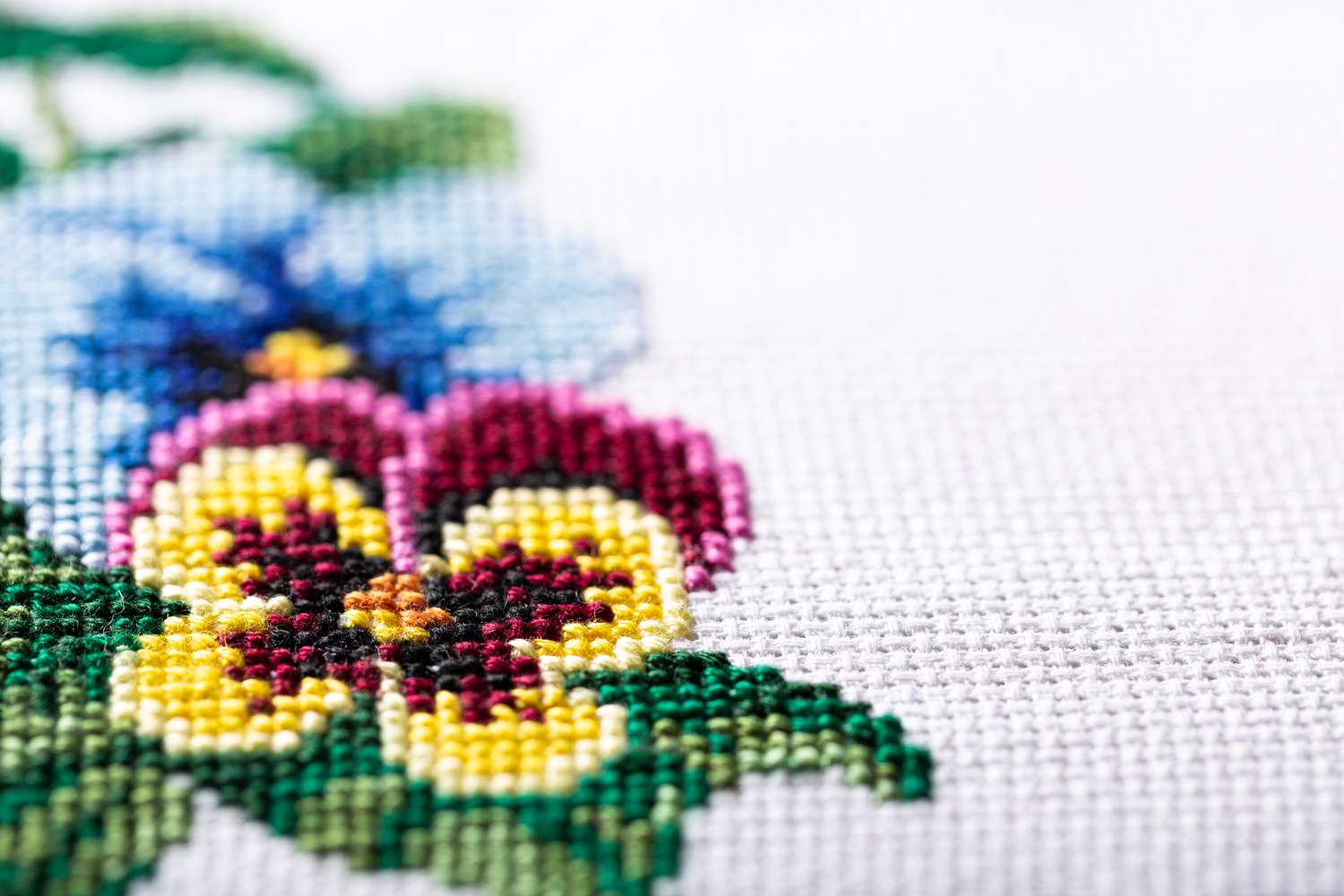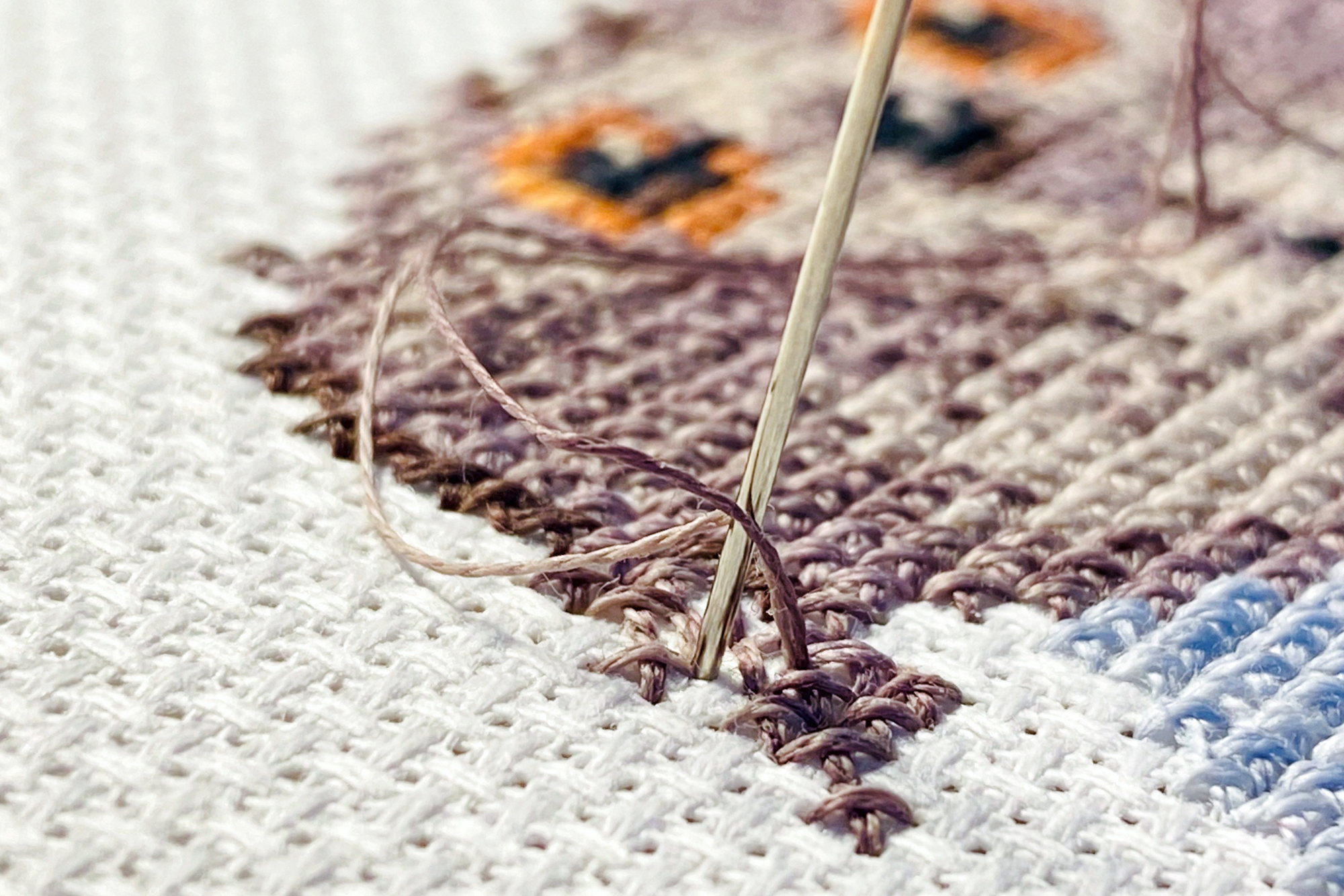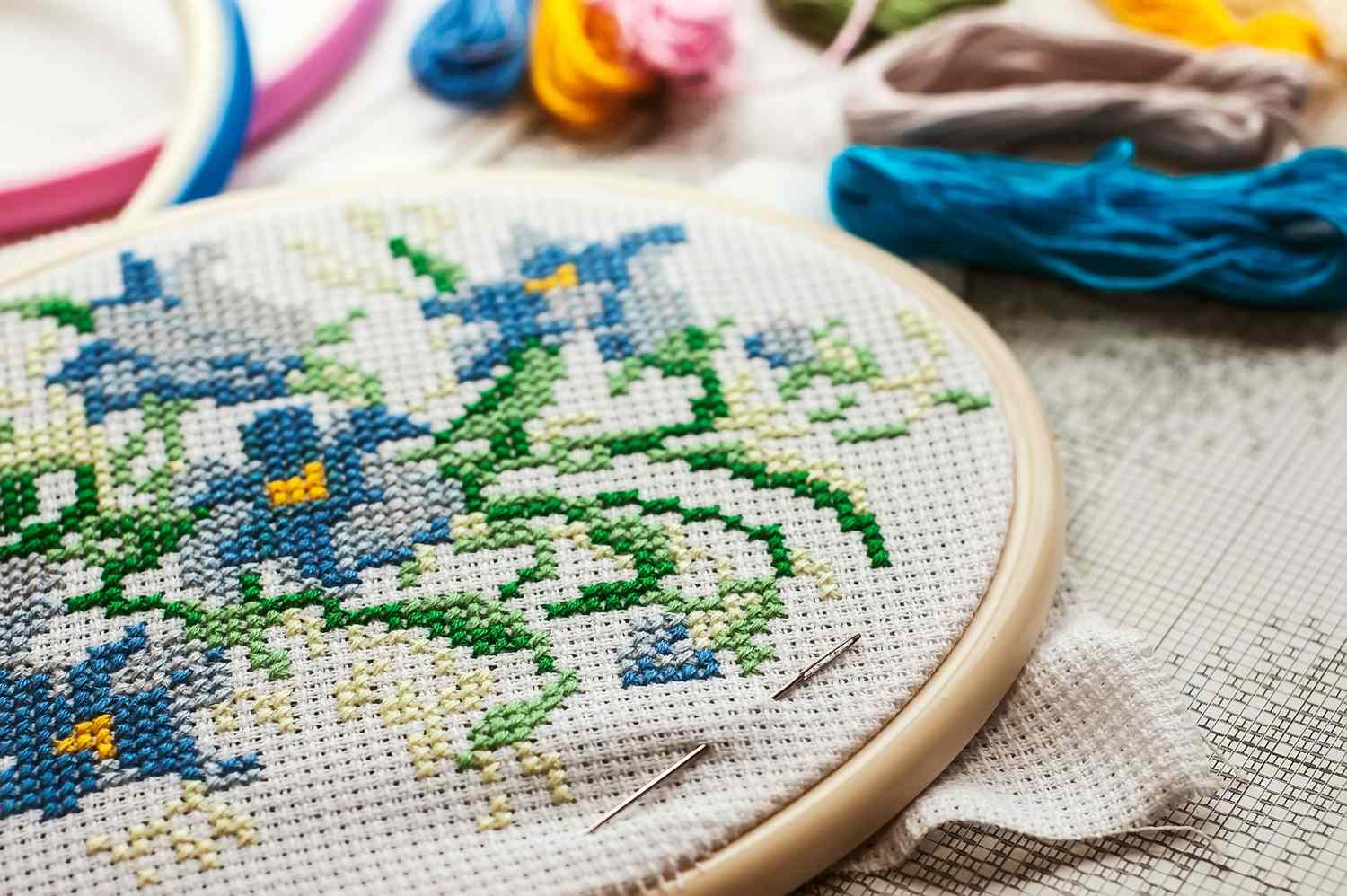Hand stitching is one of the oldest and most creative forms of textile art. Among its many variations, embroidery and needlepoint are two of the most popular. They both use a needle and thread to create designs, yet they differ in materials, techniques, and finished results.
If you are new to this craft or curious about which one to try first, this guide will help you understand the difference between embroidery vs needlepoint, their tools, methods, and best uses. We’ll also explore which technique might be easier for beginners and how to choose the right project for your skill level.
What is Embroidery?
Embroidery is the art of decorating fabric using needle and thread. It can be as simple as stitching a small floral pattern or as detailed as a large, intricate design.
Page Contents
- 1 Key Differences Between Embroidery and Needlepoint
- 1.1 Which is Easier for Beginners?
- 1.2 Tools and Materials Comparison
- 1.3 Embroidery Tools
- 1.4 Needlepoint Tools
- 1.5 Cost and Availability
- 1.6 Time and Effort
- 1.7 Applications and End Uses
- 1.8 Choosing Between Embroidery and Needlepoint
- 1.9 Step-by-Step Tips for Beginners
- 1.10 Getting Started with Embroidery
- 1.11 Getting Started with Needlepoint
- 1.12 Common Mistakes to Avoid
- 1.13 Time Investment and Finishing Differences
- 1.14 Maintenance and Longevity
- 1.15 Embroidery vs Needlepoint for Beginners – Which Should You Try First?
- 1.16 Creative Freedom and Personal Style
- 2 Conclusion
Materials and Technique
Fabric: Usually made from cotton, linen, or silk.
Threads: Cotton embroidery floss, silk, or metallic threads are commonly used.
Stitches: Popular stitches include satin stitch, chain stitch, backstitch, and French knots.
Result: The design is often stitched on top of the fabric, leaving parts of the material visible.
Embroidery is known for its flexibility. It can be used to personalize clothes, create wall decor, or make gifts. The techniques range from basic surface stitching to advanced designs that require a variety of stitch types and layers.
Skill Level
Embroidery can be learned easily by beginners. Many start with pre-printed or counted designs that teach basic stitches before progressing to more complex patterns.
What is Needlepoint?
Needlepoint, also known as canvas work, is a form of counted thread embroidery. Instead of a soft fabric, it uses a stiff, open-weave canvas.

Materials and Technique
Base: A firm cotton or linen canvas with evenly spaced holes.
Threads: Wool yarn, cotton, or silk.
Stitches: The most common stitch is the tent stitch, along with basketweave and continental stitches.
Result: The entire canvas is covered with stitching, creating a dense and textured surface.
Needlepoint designs are durable and often used for items like cushions, upholstery, or framed art. Since the entire surface is filled with thread, needlepoint projects tend to take longer than embroidery pieces.
Key Differences Between Embroidery and Needlepoint
| Feature | Embroidery | Needlepoint |
|---|---|---|
| Base Material | Soft fabric such as cotton or linen | Stiff canvas with open mesh |
| Coverage | Partial – background fabric is visible | Full – stitches cover entire canvas |
| Stitch Types | Dozens of stitches, including decorative knots | Primarily tent, continental, and basketweave |
| Threads Used | Embroidery floss, silk, metallic | Wool yarn, cotton, silk |
| Texture | Lighter, detailed surface | Thick, raised, and textured surface |
| Applications | Clothing, accessories, wall decor | Cushions, upholstery, framed canvases |
| Ease for Beginners | Easier to learn basic stitches | More structured and time-consuming |
Which is Easier for Beginners?
When comparing embroidery vs needlepoint for beginners, embroidery usually wins as the easier craft to start with.
Embroidery uses soft fabrics that are easier to handle, and it allows for creative freedom. Beginners can start with simple stitches, small hoops, and affordable materials. Mistakes can be undone easily, and patterns can be followed with minimal counting.
Needlepoint, on the other hand, involves working on a stiff canvas and requires consistent tension and stitch direction. It’s more structured and can take more time. However, once the basics are mastered, many find it relaxing and rewarding because of the beautiful, textured results.
If you’re new to needlework, starting with embroidery helps build confidence before moving on to needlepoint.
Tools and Materials Comparison
Embroidery Tools
Hoop or Frame: Keeps fabric tight while stitching.
Fabric: Cotton, linen, or silk.
Needles: Sharp-tipped embroidery needles.
Threads: Cotton embroidery floss or silk.
Scissors: Small, sharp pair for precise cutting.
Pattern: Pre-printed or hand-transferred design.
Needlepoint Tools
Canvas: Open mesh canvas with visible holes.
Frame: Keeps the canvas stretched and flat.
Needles: Blunt tapestry needles.
Threads: Wool, cotton, or specialty yarns.
Chart or Painted Canvas: Guides stitch placement.
Cost and Availability
Embroidery supplies are generally more affordable and widely available in craft stores or online. Needlepoint supplies tend to be more specialized, and the yarn required can increase the total cost.
Time and Effort
Embroidery projects can be completed quickly depending on the size and complexity. Needlepoint usually takes longer due to full surface coverage and thicker materials.
Applications and End Uses
Embroidery Applications
- Custom clothing such as shirts, jackets, and jeans
- Decorative wall art
- Table linens or napkins
- Small home decor pieces
- Personal gifts and keepsakes
Needlepoint Applications
- Cushions and pillows
- Upholstered furniture
- Belts, bags, or accessories
- Large framed wall art
- Heirloom-quality decor pieces
Both crafts allow you to express creativity, but the intended use often determines which is better. For soft, flexible designs, embroidery is ideal. For structured, durable items, needlepoint performs better.
Choosing Between Embroidery and Needlepoint

If you are new to needlework, here are a few factors to consider before choosing which craft to start:
1. Project Type
Decide what you want to make. For clothing or soft decor, embroidery is best. For sturdy decorative items, choose needlepoint.
2. Time Commitment
Embroidery projects can be completed in a few hours or days, while needlepoint may take several weeks.
3. Skill Level
Embroidery has a lower learning curve with many beginner-friendly kits available. Needlepoint requires patience and precision.
4. Texture Preference
Embroidery gives a light, flat look, while needlepoint has a raised, textured surface.
5. Material Preference
Embroidery involves smooth fabric and fine threads, while needlepoint uses thicker yarns and stiff canvas.
Step-by-Step Tips for Beginners
Getting Started with Embroidery
- Choose a simple design with clear outlines.
- Stretch your fabric in an embroidery hoop.
- Use basic stitches like running stitch, backstitch, and satin stitch.
- Keep your thread length short to prevent tangling.
- Finish the back neatly and trim loose threads.
Getting Started with Needlepoint
- Choose a small pre-printed or charted canvas.
- Mount the canvas on a frame to maintain tension.
- Start with the tent stitch for even coverage.
- Maintain consistent stitch direction and tension.
- Secure yarn ends firmly and trim neatly.
These simple habits help produce clean, professional-looking results in both crafts.
Common Mistakes to Avoid
In Embroidery
- Pulling thread too tight, causing puckering.
- Ignoring hoop tension.
- Skipping knots or loose thread ends.
- Using incorrect needle sizes.
In Needlepoint
- Uneven tension resulting in warped canvas.
- Miscounting stitches and losing alignment.
- Using yarn that’s too thick for the canvas holes.
- Leaving the back messy and bulky.
By working carefully and practicing regularly, you can avoid these common problems and enjoy the process more.
Time Investment and Finishing Differences
Embroidery pieces can often be completed in shorter sessions. You can pause and resume easily, making it suitable for casual hobbyists or those with limited time.
Needlepoint requires a bit more dedication since each hole in the canvas must be filled with stitches. The final product, however, tends to last longer and maintain shape due to the heavier canvas and yarn.
When framing or displaying, embroidery works well in hoops or frames under glass. Needlepoint may be stretched and framed or sewn into cushions or upholstery pieces.
Maintenance and Longevity
Embroidery pieces should be kept away from moisture and direct sunlight to prevent fading. Washing should be gentle and preferably by hand.
Needlepoint is more durable but should also be protected from prolonged sunlight and damp conditions. Since it’s denser, it can collect dust more easily, so occasional gentle cleaning is recommended.
Embroidery vs Needlepoint for Beginners – Which Should You Try First?
If you’re new to stitching, embroidery is often the best starting point. It offers flexibility, quicker results, and a wide range of designs. It helps you learn key hand-sewing skills like thread control, pattern following, and neat finishing.
Once you’re confident, transitioning to needlepoint becomes easier. You’ll already understand thread tension, stitch direction, and project planning.
However, if you love structure and prefer a more methodical approach, needlepoint might suit your style from the beginning. The repetitive stitches can be relaxing and meditative once you find your rhythm.
Creative Freedom and Personal Style
Embroidery allows freehand creativity. You can sketch your own designs, use colored threads to create gradients, and mix various stitches for texture.
Needlepoint is more structured since it relies on canvas grids. The results are neat, uniform, and often geometric. Some find this structure comforting, as it provides a clear framework to follow.
Both crafts offer creative satisfaction in different ways.
Conclusion
Both embroidery and needlepoint are beautiful forms of needlework that allow you to express creativity while producing lasting decorative pieces.
Choose embroidery if you want flexibility, lighter materials, and faster projects.
Choose needlepoint if you prefer structured stitching, textured finishes, and long-lasting results.
Whether you stitch for relaxation, learning, or creating handmade decor, both crafts bring joy and mindfulness. Starting small, learning steadily, and experimenting with new designs will help you master either art form and develop your unique stitching style.

